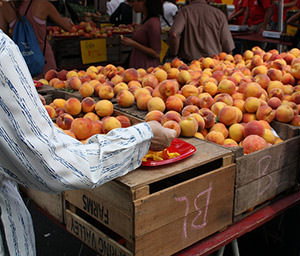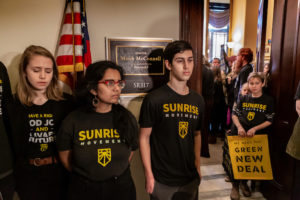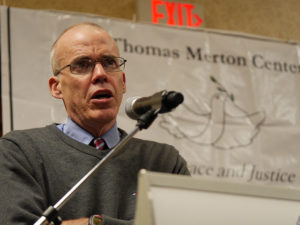Growing an Alternative Economy One Community at a Time
"The best thing about farmers markets is that people talk," says environmentalist Bill McKibben. "A study found that shoppers at farmers markets had 10 times as many conversations per visit than at supermarkets.""The best thing about farmers markets is that people talk," says environmentalist Bill McKibben.
By Thomas Hedges, Center for Study of Responsive Law
On Sunday mornings, farmers, producers and consumers meet in Dupont Circle in Washington, D.C., and exchange locally grown products. Bright fruits, vegetables and flowers are lifted from large tables and brought to the cash register, where shoppers and farmers talk at length. Others taste cheeses and sample slices of tomato, pausing to savor the taste or read a handout detailing the food’s provenance.
The apples, pears, potatoes here are collected from farms within 150 miles of where they are sold. The men and women behind each stand are often the farmers themselves. Pesticides, antibiotics and artificial growth hormones are banned. Fresh Farm Markets, a not-for-profit organization that oversees and regulates the farmers market in Dupont Circle, travels to each farm to make sure that regulations are followed.
Any producers, whether they sell jam, pastas, or soups, must prove that their ingredients are from the region.
“We work with the locals,” says Isabel Castillo, co-owner of Dolcezza Artisanal Gelato. “I have apples from here, pears from here, ricotta from here. I support here.” Castillo makes the gelato in her flagship store on Wisconsin Avenue and Q Street. She has two other stores. “My son-in-law is the chef and my daughter and husband and I manage the shops,” she says.
The vibrancy here reaches beyond the mere color of the produce. It’s found in the conversations between shoppers and vendors, which point to a level of care in how people are consuming. It’s about more than health. It’s about buying food that hasn’t traveled thousands of miles to get here, and the impact that has on the environment.
“The best thing about farmers markets is that people talk,” says environmentalist Bill McKibben. “A study found that shoppers at farmers markets had 10 times as many conversations per visit than at supermarkets.”
“That’s one way we reknit the community, lost as America sprawls outwards,” he says.
The farmers market is a microcosm of an alternative economy. It is marked by conversation, not by profit.
In recent years, chain stores like Whole Foods and Sun Organic Farm have sought to graft this local economy onto an international business model. In its mission statement, Whole Foods declares “we promote environmental stewardship.” But “we are not a fully self-sustaining ecosystem,” it says afterward. “There are hundreds of other businesses that we depend on to assist us in creating an outstanding retail shopping experience for our customers.”
The message from environmentalists like Michael Pollan, Wendell Berry and Bill McKibben is that it is doubtful that international chains will be the ones to spearhead the “buy local” movement. Instead they create a “shopping experience” for customers, one that satisfies us even if it means lying about the use of GMOs in the food they sell.
The problem is that stores such as Whole Foods, can’t make up their minds, McKibben says. “Eat seasonally — and when you go to Whole Foods, tell them you’re not buying the Chilean raspberries because they make a mockery of the store’s commitment to doing something good for the planet.”
Food transportation, or “food miles,” is a non-issue in mass media. The chemicals used to treat the food are covered. Its healthfulness is covered. But not its carbon footprint.
The New York Times has featured two articles on this issue in the past five years, both of which end by defending the global food market.
James McWilliams wrote in the 2007 article “Food That Travels Well,” that researchers “found that lamb raised on New Zealand’s clover-choked pastures and shipped 11,000 miles by boat to Britain produced 1,520 pounds of carbon dioxide emissions per ton while British lamb produced 6,280 pounds of carbon dioxide per ton, in part because poorer British pastures force farmers to use feed.
“In other words,” he wrote, “it is four times more energy-efficient for Londoners to buy lamb imported from the other side of the world than to buy it from a producer in their backyard. Similar figures were found for dairy products and fruit.”
But McWilliams never addressed the obvious. Why not sacrifice the lamb? If it’s better to import lamb from halfway around the world than to raise it locally, why not simply eat something else?
We can’t pin the problem of food trade on any single store. Whole Foods is, in fact, one of the more progressive supermarkets in some ways. It caps the amount of money executives make, for example, and makes an effort to collect local produce for retail.
But local food amounts to only 10 to 30 percent of what’s on the shelves.
It is in that other 70 to 90 percent — the coffee from Africa, the tomatoes from Chile, the lentils from Morocco — that we see where Whole Foods truly stands on the global vs. local food issue. Unlike a small farmers market, there is no conversation between grower and consumer, no initiative to move toward self-sustainability, and no acknowledgment of the energy that goes into transporting food overseas. Without the communication and community found in places like Dupont Circle on Sunday mornings, chain corporations cannot opt out of the global food market that is destroying the planet, and stay in business.
This article was made possible by the Center for Study of Responsive Law.
Your support matters…Independent journalism is under threat and overshadowed by heavily funded mainstream media.
You can help level the playing field. Become a member.
Your tax-deductible contribution keeps us digging beneath the headlines to give you thought-provoking, investigative reporting and analysis that unearths what's really happening- without compromise.
Give today to support our courageous, independent journalists.






You need to be a supporter to comment.
There are currently no responses to this article.
Be the first to respond.